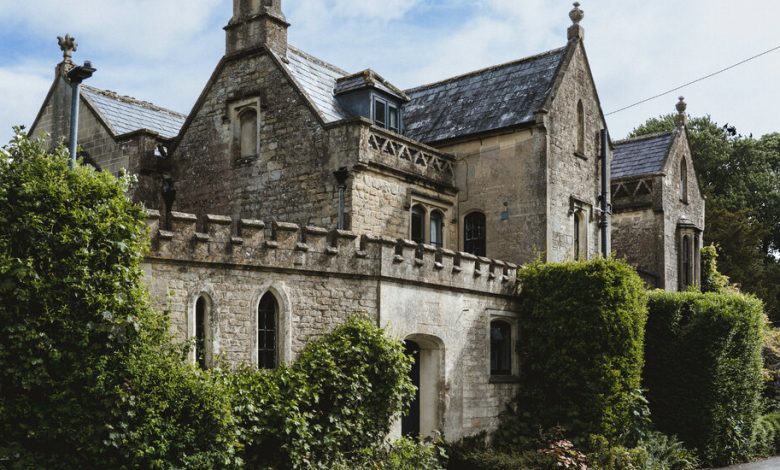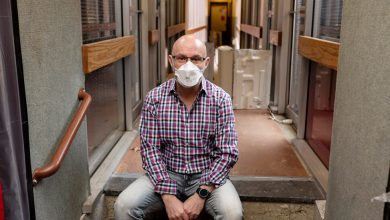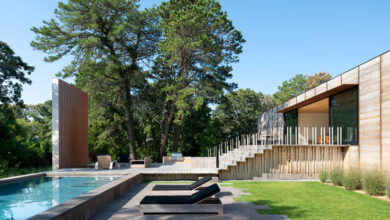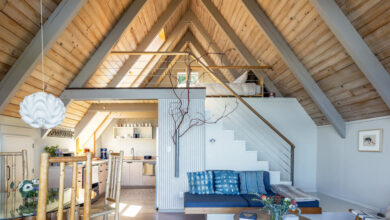House Hunting in England: A Six-Bedroom Starter Castle for $2 Million

[ad_1]
An 1820 Limestone House in South West England
$2.1 MILLION (1.695 BRITISH POUNDS)
This Tudor Revival-style house, built in 1820 around a 17th-century core and expanded in 1920, sits on the periphery of Calne, a medieval market town in Wiltshire County, in South West England. Known as Castlefields, the six-bedroom home was originally part of a 200-acre estate used for hunting grouse and partridge, and is a protected historic property with a “grade two” on the National Heritage List for England.
The property occupies a third of an acre at “the edge of fields,” making it possible to “walk out of the door into the countryside, which is heaven,” said Rebecca Hall, the owner along with her husband, Alex. The house is listed with Inigo, an estate agency for historic homes.
The three-level, 6,000-square-foot house, built of coursed limestone, has a slate cross-gabled roof and 15 octagonal chimney stacks corniced at the tips. Parapet walls by the entrance porch have crenelated stonework, lancet windows are mullioned and doorways are arched. Three- and four-leaf clover motifs abound.
Wood gates open to a gravel driveway with space for several cars. A flagstone porch and double front door lead to a vestibule and entrance hall with original polished sandstone floors and a cantilevered stone staircase. A domed ceiling has plaster detailing and a cornice.
The ground floor continues in a circular plan. A study with a built-in bookcase and a bay window of four arched panes is followed by a den and an orangery. Across the entrance hall is a powder room and drawing room. The spacious kitchen has a forest-green dresser with a reclaimed oak counter and display shelves. Matching cabinets were built to either side. The kitchen and all but one bathroom have 12-inch-wide elm plank flooring.
A service kitchen with another refrigerator and oven is hidden behind the central kitchen. “It’s great if you’re entertaining,” Ms. Hall said. “You can have all the mess in there.” The adjacent orangery is used as a dining room, and opens to a stone terrace.
Upstairs are six large, carpeted bedrooms. The primary, with a vaulted ceiling and bay window, has a contemporary en suite bath with travertine tile. The adjacent dressing room is also a bedroom, and a third bedroom is used as a study. A back staircase leads down to a first-floor utility room with laundry and workbench areas. Beyond is a shower room and a mud room with access to the garden.
The attic has exposed beams, a sitting room, two small bedrooms, a bathroom and a long storage room which “would be a cool space for a nanny or au pair,” Ms. Hall said.
The three-room cellar, which approximates the house footprint, includes a large fireplace and a wine-cellar area. The original spring well extends from the basement to the neighboring River Marden, a tributary of the River Avon.
Latticework fencing, yew hedges and a canopy of Catalpa trees encircle the property’s verdant lawn. In season, wisteria, roses and climbing hydrangeas bloom against the stone walls. A bamboo hedge separates a discrete cottage with two one-bedroom apartments.
The house adjoins Castlefields Park, named for a 12th-century castle that no longer exists, and is also near a national cycling route from London to Bristol. The town of Calne, with about 18,000 residents and various shops and restaurants, is about five minutes away by car. Bath, the Victorian spa town, is 40 minutes west. Stonehenge, the prehistoric stone circle monument, is 45 minutes south.
The train to London Paddington station takes about 68 minutes and is available twice hourly from Chippenham rail station, a 15-minute drive. Bristol International Airport is 50 minutes west.
Market Overview
The country markets in South West England “have had a huge amount of uplift the last two years, but that is on the back of being static for a long time,” said George Nares, director of the country department at Savills.
House prices in the South West grew by 6.3 percent from the first quarter of 2021 to the first quarter of 2022, according to data provided by Tim Vooght, the national PR manager at Savills. Top performers include the cities of Truro, which rose 16.7 percent, and Exeter, up 12.1 percent. The most significant increase was in the number of home sales above 500,000 British pounds ($652,000), which rose 167 percent from 2019 through 2021.
Before the pandemic, buyers “wanted to be within a commuting distance, an hour from the center of London,” said Hamish Humfrey, a partner in Knight Frank’s country department. When the market reopened after the 2020 Covid-19 lockdown, parameters broadened. “There is a huge amount of demand for people coming out of London looking for a different lifestyle” in the countryside or along the coast, Mr. Humfrey said.
Potential market dampeners, including a struggling economy, threats of interest rate increases and the war in Ukraine, “don’t seem to be affecting demand, particularly for the more prime properties,” Mr. Nares said, noting that some buyers are seeking to move their main residence to the country and keep a pied-à-terre in London.
Before the pandemic, the South West “was a relatively good value — 15 to 25 percent less than other areas of the country,” Mr. Humfrey said. As prices have risen, “it’s more on par, but it is still perceived to be an area where you will get more for your money.”
Areas including West Sussex, Cornwall, Devon, Somerset, Wiltshire and Gloucestershire are hot, said James Klonaris, the prime appraisals manager with Inigo, the estate agency. Modern and contemporary homes are in demand from Brighton to Chichester along the coast.
Bath is also “a big draw” for Londoners who moved out to get more space or a rural feel, “yet still like the benefits of a city,” Mr. Nares said.
With a focus on design and aesthetics, Inigo sells most of its listings in the range of 1 million to 7 million pounds ($1.2 to $8.6 million), with properties often covering around four acres. “A lot of people use it as protection from development around them,” Mr. Klonaris said.
Demand is most robust for homes that are complete and don’t need much work, whether they’re 500 years old or contemporary, Mr. Humfrey said. He added that buyers are also clamoring for Georgian country houses with discrete ancillary accommodations and a “block of land,” perhaps 100 acres. These typically sell for between 2 million and 5 million-plus pounds ($2.5 and $6 million-plus). With supply lacking over the past two years, “there are many bidding wars,” he said.
But with more homes “creeping onto the market,” Mr. Klonaris expects a hectic summer: “In a market of rising inflation, it is a very viable asset class and one you can enjoy.”
Who Buys in Southwest England
“An exodus of the young” from London are buying country homes, Mr. Klonaris said. Customers from the United States “ebb and flow,” while other international buyers come from Canada, Germany, France, Denmark, Sweden and Australia.
The range of international buyers is more extensive closer to London, including many Europeans whose work takes them there, Mr. Nares said.
Mr. Humfrey said that expatriates who spent the past decade in Singapore, Hong Kong or Dubai are coming back and buying country homes.
Buying Basics
There are no restrictions on foreign buyers in England.
Most British lenders do not lend to non-British residents, “so an overseas buyer will have fewer mortgage options,” said Dominika Bullegas, a real estate lawyer with the firm Healys. However, specialist lenders and international banks may help.
A “full structural survey” of the internal and external areas of the property is recommended, Ms. Bullegas said.
A lawyer can oversee the sale from contract through closing, including registering the transferred title with the HM Land Registry. At Healys, legal fees are fixed based on the purchase price and complexity.
A lawyer specializing in properties of architectural or design interest is recommended for protected homes, Mr. Klonaris said, estimating legal fees from 2,500 to 15,000 pounds ($3,100 to $18,400).
The seller pays the commission, typically 1 to 3 percent of the sale price plus a value-added tax. Stamp duties are 2 percent higher for nonresidents. If a buyer already owns a home, there is an additional 3 percent charge. Duties range from 5 percent to 12 percent, depending on price.
Websites
Languages and Currency
English; pound sterling (1 pound = $1.25)
Taxes and Fees
The annual property tax on this house is 3,500 pounds ($4,300).
Contact
James Klonaris, Inigo, 011-44-20-3687-3071; inigo.com.
For weekly email updates on residential real estate news, sign up here. Follow us on Twitter: @nytrealestate.
[ad_2]
Source link






